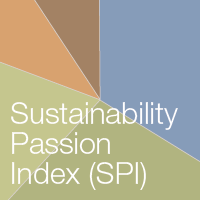 My new column for Greenbiz which will feature exclusive SHIFT Report data, launched this week with cool infographics on political affiliation and sustainability. Here is the article:
My new column for Greenbiz which will feature exclusive SHIFT Report data, launched this week with cool infographics on political affiliation and sustainability. Here is the article:
I was recently at lunch with two friends, one of whom brought her husband. After the couple departed, I found myself apologizing to my other friend for the husband’s rude behavior, the mildest part of which included leering gestures at the waitress and comments that don’t need to be repeated.
“Don’t worry about it,” he responded. “I always try to focus on the points of alignment with someone. There’s always something. And once I found them, it was an interesting conversation where we were both engaged.”
Alignment is crucial.
As businesses seek to define and tell their sustainability story in the landscape of shifting consumer values — which they must do in order to be culturally relevant — there has been significant focus on environmental issues where there is less likely to be alignment and which aren’t necessarily the most important to some people.
Sustainability (a word so overused, misused and abused that I’ve started calling it the S-Word) is about the issues that lie underneath it. These are a collection of issues that include but go beyond green and include personal, social and spiritual sustainability issues.
This was uncovered both qualitatively and quantitatively in our market intelligence tool, The SHIFT Report. These sustainability issues are important to mainstream consumers in varying degrees. However, across most consumers groups — from either a brand consumption, activity, demographic, lifestyle or political point of view — green issues are not necessarily the most important ones. They are significantly surpassed in importance by social and personal sustainability issues: community connection, fair trade and employee treatment. These are areas consumers feel personally affected by or connected to, and represent two key motivations for caring about brands and companies.
People aren’t waking up across the globe declaring, “I want a green life.” Rather, they are waking up saying that they want a connected, conscious, thriving and sustainable life (though they don’t necessarily use those words). Brands and their storytellers need to understand this in order to define and tell their stories and engage consumers in conversations. As one respondent put it during one of our focus groups, “How can we take care of the environment if we can’t even take care of ourselves?”
Environmental sustainability is crucial, but it’s not the only piece of the puzzle. Green needs to be looked at in the context of other sustainability issues, not in a silo. Green may turn out to be the best color of a brand’s sustainability message, but it might not be.
Unless brand manager focus on the issues that define a brand and determine which issues authentically align with their initiatives and audience, they risk making misleading claims, not connecting with their audience and potentially alienating others. When brand managers targeting a diverse global or national audience look primarily at environmental issues without interconnection and context to broader sustainability issues, the result can be a brand experience that doesn’t bring disparate and diverse audiences together, but keeps them apart. Looking at green in a silo doesn’t reflect a big-picture understanding of the cultural shift to sustainability, in which people are redefining the criteria by which they make lifestyle choices, purchases and brand decisions, It misses the forest for the trees, and in doing so can also reinforce sustainability myths, such as that those on the political left are more engaged with sustainability than those on the political right.
Indeed, looking at political parties in the U.S. and Canada and how voters connect with sustainability issues is a good way to assess brand alignment within a mass and diverse mainstream audience. For Republican and Democrat voters (or, in Canada, Conservative, Liberal, NDP and Green Party voters), alignment is not necessarily around environmental issues, it’s around all the other issues: schools, housing security, health care and general well-being. This bigger-picture, interconnected approach doesn’t minimize the importance of environmental sustainability. But it delivers on its importance in a different way.
Let’s take look at two social sustainability issues where there is alignment across a diverse audience: community connection and supporting locally based business, which are themselves interconnected. With the support of local business and local economies, the environment becomes the beneficiary (such as lower greenhouse gas emissions) rather than the direct strategy. Environmental sustainability issues are supported, but they are a direct result of focusing on key areas of alignment across a diverse audience: buying local and supporting locally based business.
Thus, brands — political or otherwise — that speak to a diverse audience have two key words to keep in mind when telling their story in a culture of shifting consumer values: authenticity and alignment. What can they authentically talk about given their initiatives around sustainability? And where do these internal sustainability truths align with their diverse audience?
Determining the sweet spot that aligns these truths will uncover opportunities that deliver on business priorities to drive positive change and business success.







Hi Kiersten,
Thanks so much for this thoughtful post. One of the things I notice when I think about these issues that that I want to see companies in integrity with their stated beliefs about the environment. A recent example is Orbitz. They claim to support sustainability and reducing carbon emissions, then support Fox News with their ad dollars. This sort of behavior, claiming one thing and doing another, creates confusion for the customer. Do I support Orbitz because they’re “green” or do I avoid them because they’re putting dollars into an organization which is, at best, not a friend of the environment.
I urge companies to work to be in alignment and integrity with their stated values–in all areas of their business, from marketing to spending.
With gratitude,
Tara